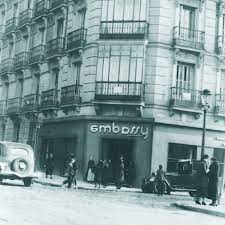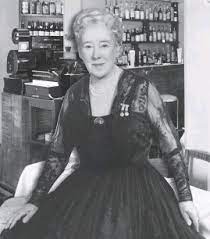Europe
Margaret Kearney Taylor–The Woman whose Tearoom Saved Countless Lives

Margaret Kearney Taylor helped thousands of Allied servicemen and Jewish refugees flee the Nazi regime through Madrid during the second world war.
Almost unbelievably, this was done from the upstairs of a tearoom a stone’s throw from the swastika decorated German embassy on Paseo de la Castellana, one of the main avenues running through the Spanish capital Madrid.
Born into poverty, founding a fashionable tearoom, rubbing shoulders with the Spanish elite and saving countless lives from under the noses of the Nazis, the life of Margaret Kearney Taylor certainly wasn’t run of the mill.
Taylor was born in a workhouse in England to a mother who was herself born in a workhouse in Kanturk County Cork.
From her meagre start in life she founded the Embassy tearoom in Madrid in 1931. Along the way she spent time in Paris in the 1920s and had a daughter named Consuelo with Spanish diploma, José María Linares Rivas. She subsequently won a paternity case against Rivas so that Consuelo could use her father’s name. For a woman to take a case of this type a century ago points to a determined and steely character, which she would put to good use in Madrid years later.
Margaret and the Embassy had a way of doing things which was unique in Madrid at the time. In the afternoon tea, cakes and sandwiches could be ordered but in the evening the cocktails were served and the tearooms became a firm favourite of the great and the good in Spanish society.

Margarita, as she was called by those who knew her, made the ideal host and the stylish café ran like clockwork, where she built friendships with some very influential people who would later prove useful when she was smuggling people through Madrid on their way to freedom outside Europe.
These friends included Frederika, the queen mother of Greece, whose daughter Sofia would become queen of Spain and Ramón Serrano Suñer.
Suñer was the brother-in-law of Spanish Dictator General Franco and served as foreign minister during the war. He also believed firmly in the Nazi ideology and received Himmler when he came to Madrid in 1940. He would have had a certain degree of influence over Franco and was probably one of the reasons the café avoided being raided during the war. After all the only thing that separated the German Embassy and the cafe was a Lutheran church.
This location is truly remarkable because as well as flying the swastika outside its doors, the German Embassy doubled as the headquarters of the Nazi intelligence unit in Spain and had 1000 agents in the Spanish capital alone.
The safe house that operated above the tearooms saw many refugees come from Miranda de Ebro, a concentration camp 330km north near Bilbao. They were taken from the camp using fake medical records stating they had illnesses such as Typhus or Tuberculosis and transported around using Red Cross ambulances or British Embassy cars which had diplomatic immunity.
Once in the apartment, they were provided with ID cards by the British embassy and smuggled on to ports in Portugal or Gibraltar for onward travel to safety. The number of people smuggled through Spain in this way numbered roughly 30,000 and the Madrid operation which Margaret was part of saved countless lives.
She kept the operation a secret right up to her death almost forty years after the war ended. When it emerged that she was part of the daring operation her friends could hardly believe it because of her genteel nature and charming manner which would have put her at odds with taking her life in her hands on a daily basis for the years of the war.
Adriana Rivera Sarmiento, a subsequent owner of the Embassy who knew Taylor as Granny said of her, Can you imagine to have that courage. To have this confidence, to have this charade right here and the German embassy up the street.
On her death in 1982 she left the Embassy tearoom to her staff and it finally closed its doors in 2017 after 86 years in business. A ground breaking café that served tea, sandwiches and cocktails to aristocratic ladies, royals and Nazi sympathisers and at the same time saved the lives of countless people fleeing the Nazi regime.
